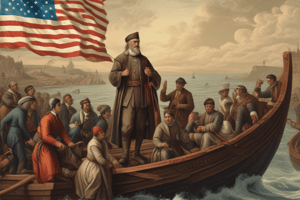Podcast
Questions and Answers
Railroad companies actively recruited workers in ______.
Railroad companies actively recruited workers in ______.
Europe
Many immigrants began work as agricultural ______.
Many immigrants began work as agricultural ______.
laborers
Between 1820 and 1880, 70 percent of immigrants to the United States came from Great Britain, ______, and Ireland.
Between 1820 and 1880, 70 percent of immigrants to the United States came from Great Britain, ______, and Ireland.
Germany
The Irish were the first Roman Catholics to arrive in large numbers in what was largely a ______ country.
The Irish were the first Roman Catholics to arrive in large numbers in what was largely a ______ country.
As immigrants poured into the United States, many U.S. citizens worried about the new ______.
As immigrants poured into the United States, many U.S. citizens worried about the new ______.
What was the primary focus of the Naturalization Act of 1790 regarding citizenship in the United States?
What was the primary focus of the Naturalization Act of 1790 regarding citizenship in the United States?
Before 1820, how did the United States handle the tracking of immigrants arriving by ship?
Before 1820, how did the United States handle the tracking of immigrants arriving by ship?
Which geographical regions primarily influenced the early settlers who authored the Declaration of Independence and the Constitution?
Which geographical regions primarily influenced the early settlers who authored the Declaration of Independence and the Constitution?
What did the U.S. Constitution imply about immigration and citizenship?
What did the U.S. Constitution imply about immigration and citizenship?
What general attitude towards new immigrants was expressed in the statement about America being open to receive the 'oppressed and persecuted'?
What general attitude towards new immigrants was expressed in the statement about America being open to receive the 'oppressed and persecuted'?
Study Notes
Turn-of-the-Century Immigration
- Railroad companies actively recruited workers from Europe, while steamship companies promoted the United States as a land of opportunity to boost ticket sales.
- Many immigrants worked as agricultural laborers, while others settled in cities and found jobs as servants or factory workers.
- The mining industry in the West employed a significant number of immigrants.
- Between 1820 and 1880, 70% of immigrants to the United States came from Great Britain, Germany, and Ireland.
- The Irish were the first Roman Catholics to arrive in large numbers in the predominantly Protestant United States.
Immigration and Discrimination
- Immigrants often faced hardship and discrimination despite finding opportunities in the United States.
- As immigration surged, U.S. citizens grew concerned about the social and political implications of the new arrivals.
- The Know-Nothing Party emerged, reflecting the anxieties about the influx of immigrants, particularly Irish and German immigrants.
- Japanese immigrants began arriving in the late 19th century as their government allowed emigration for the first time in 300 years.
- Facing discrimination, they were labeled as hard workers willing to work for low wages, leading to the "yellow peril" concept.
- San Francisco segregated schools, separating Asian children from others.
The Gentlemen's Agreement
- The Japanese government protested the discrimination to President Theodore Roosevelt.
- In 1907, the Gentlemen's Agreement was reached, where Japan agreed to limit emigration to the United States in exchange for reduced discrimination.
The National Origins Act of 1924
- The act was influenced by the Dillingham Commission's investigation of immigration and its effects.
- It aimed to reduce and regulate immigration, emphasizing limiting the number of immigrants admitted from each country.
- The act established quotas for each European nationality based on their proportion in the 1890 U.S. population.
- This drastically reduced immigration from countries like Italy, Hungary, and Poland whose immigration surged after 1890.
- It also reinforced earlier laws that severely restricted immigration from Asia.
The Cold War and Immigration
- World War II sparked a period of technological innovation and economic growth in the United States, making it a global superpower.
- The Cold War, characterized by the struggle between communist and capitalist blocs, impacted the United States' role in the world and its immigration policies.
- Following World War II, the United States adopted a policy of accepting refugees from communist countries.
The Displaced Persons Act of 1948
- This act permitted the entry of over 400,000 refugees displaced by World War II and the rise of Soviet communism in Eastern Europe.
- It was followed by special bills in the 1950s and 1960s offering refuge to "escapees" from communist countries.
- The largest wave of refugees, about 700,000, came from Cuba after Fidel Castro's communist revolution in 1959.
- The United States rejected refugees from countries not explicitly escaping communism, like Central America during civil wars.
1965 Immigration Act
- This act partially loosened restrictions on Asian immigration.
- It replaced the old quota system with new criteria focused on family reunification and attracting skilled professionals.
- This resulted in a significant boost in immigration from non-European countries, who were previously limited under the quota system.
- Despite strict regulations, undocumented immigration and refugee claims increased.
- Backlogs of applicants accumulated in the official immigration channels.
### Immigration Policy Defined
- Migration is moving into another country with intent to live there permanently.
- Emigration is moving out of one country to live in another.
- The U.S. Constitution primarily gave Congress the authority to make decisions related to immigration and granting citizenship.
- 1924 was the year citizenship was granted to anyone born within the borders of the U.S.
- Native Americans were not granted full citizenship until 1924.
19th Century Immigration
- The U.S. was attractive to immigrants in the 1800s due to the problems in Europe at this time.
- The U.S. needed workers to fuel its growth throughout the 1800s.
Japanese Immigrants
- Japanese immigrants arrived in the United States in the 1800s.
- Prejudice against Japanese people eventually emerged, labelled as the “yellow peril.”
- San Franscisco created segregated schools, separating Asian children from others.
- The Japanese government protested to President Theodore Roosevelt, who created the Gentleman’s Agreement of 1907, which limited Japanese emigration to the U.S.
### Early 20th Century Immigration
- At the end of the 19th Century, an anti-immigration movement emerged to limit the number of immigrants entering the U.S.
- The Dillingham Commission (1911) investigated immigration and recommended regulations to reduce immigration numbers.
- The Dillingham Commission recommended a cap be placed on the number of immigrants from each country based on proportion to the U.S. population in 1890.
The National Origins Act of 1924
- The National Origins Act of 1924 limited the number of immigrants from specific nations.
- This effectively reduced the number of Italian, Hungarian, and Polish immigrants.
- Asian immigration was significantly reduced through this act.
### Immigration Policy in the 1980s
- Immigration policy in the 1980s shifted to focus on allowing undocumented immigrants who had lived in the United States since 1981 to gain legal citizenship.
- The amnesty program granted legal status to 3.2 million immigrants.
### Immigration Policy in the 1990s
- The Immigration Act of 1990 expanded the number of annual immigrants admitted to the U.S. to 675,000 from 290,000.
- The number of immigrants admitted to the U.S. with specialized work skills and their families was nearly tripled through this act.
- This Act reiterated the importance of family reunification in immigration policy.
### Immigration Policy After 2000
- The Illegal Immigration Reform and Immigrant Responsibility Act of 1996 focused specifically on curbing illegal immigration.
- This act made it easier to deport undocumented immigrants and reject asylum claims.
- This act was passed due to economic troubles of the early 1990s, though economic conditions had improved significantly by the time it became law.
### The Real ID Act of 2005
- The Real ID Act was created in response to recommendations from the 9/11 Commission.
- This act enforced more rigorous standards for obtaining state-issued identification cards.
- The purpose of this act was to improve national security.
- As of 2013, only 19 states were in full compliance with this act.
### Immigrants in the U.S.
- Immigrants who want to become U.S. citizens can apply for citizenship, however certain requirements must be met.
- Requirements include holding a green card (permanent residence) for over five years, speaking English, and passing a U.S. history and civics test.
- The immigration debate has become more complex in the last two decades with a greater focus on national security after the 9/11 attack and economic troubles.
- The economic recession of 2007 led to further scrutiny of immigrants, their use of social services, and their role in the workforce.
- Anti-immigrant sentiments have increased in response to these domestic policy concerns.
Studying That Suits You
Use AI to generate personalized quizzes and flashcards to suit your learning preferences.
Related Documents
Description
Explore the waves of immigration to the United States from 1820 to 1880 in this quiz. Learn about the various economic roles immigrants took on and the discrimination they faced. Assess your knowledge of the demographics and societal impacts of this pivotal period in American history.




